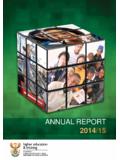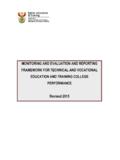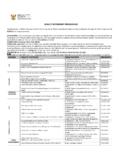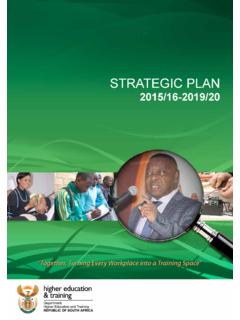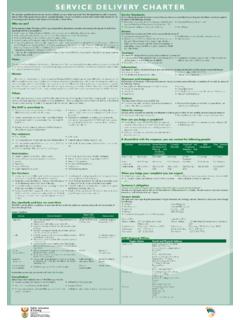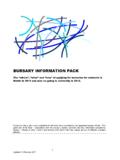Transcription of Report of the Task Team on Community Education and ...
1 Report of the Task Team on Community Education and training Centres Summary Department of Higher Education and training ii X iii Table of contents List of tables and charts .. iv Abbreviations and acronyms .. v Introduction: background and methods .. 1 Section 1. South Africa's developmental agenda and Education opportunities for adults and young people .. 3 Section 2. Reviews of the literature on appropriate institutional forms of lifelong learning .. 15 Section 3. Community research: imagining Community Education and training centres .. 23 Section 4. Proposals on a new institutional model .. 33 Section 5. Implementation steps: the way forward .. 51 References .. 53 Appendix 1: Submissions from and engagements with stakeholders .. 55 Report of the Task team on Community Education and training Centres. Summary iv List of tables and charts Table 1: Summary of institutional forms providing learning opportunities for adults and youth.
2 9 Table 2: Summary of supplementary institutions supporting Education for adults and youth .. 11 Table 3: Targets for 2030 enrolment in the Post-school sector .. 12 Table 4: Examples of existing Community Learning Centres by institution type .. 21 Table 5: Youth and adult target groups and learning needs .. 36 Table 6: Proposed institutional model for adult and youth Education .. 39 Table 7: Advantages and disadvantages of proposed options .. 45 Figure 1: Framework for Community Education and training Centres .. 29 Figure 2: Option 1: Community Learning Centres a part of a three-tier post-school sector .. 44 Figure 3: Option 1: Community Learning Centres a part of a two tier post-school sector .. 44 v Abbreviations and acronyms ABET Adult Basic Education and training AET Adult Education and training CBO Community Based Organization CETC Community Education and training Centre CHET Centre for Higher Education Transformation CLC Community Learning Centre DBE Department of Basic Education DHET Department of Higher Education and training DSD Department of Social Development EPWP Expanded Public Works Programme FBO Faith Based Organization FETI Further Education and training Institute FET Further Education and training FTE Full-time equivalent GDP Gross Domestic Product GET General Education and training GETC General Education and training Certificate HE Higher Education HEI Higher Education Institution LED Local Economic Development NASCA National Senior Certificate for Adults NATED National Technical Education NCV National Certificate (Vocational)
3 NDP National Development Plan NEDLAC National Economic Development and Labour Council NEET Not in Employment or in Education or training NEPI National Education Policy Initiative NGO Non-Governmental Organization NPC National Planning Commission NPFET National Plan for Further Education and training Colleges NPO Not for Profit Organization NQF National Qualifications Framework NSF National Skills Fund NSFAS National Student Financial Aid Scheme of South Africa NSC National Senior Certificate NSDS National Skills Development Strategy NYDA National Youth Development Agency ODL Open and Distance Learning OER Open Educational Resources PALC Public Adult Learning Centre QCTO Quality Council for Trades and Occupations RPL Recognition of Prior Learning SAQA South African Qualifications Authority SETA Sector Education and training Authority YAC Youth Advisory Centre vi Page 1 Introduction Background and methods Terms of reference of the Task Team 1.
4 The Department of Higher Education and training Task Team on Community Education and training Centres (CETCs) was appointed in April 2011 and submitted its final Report on 25 May 2012. Its task was to investigate and recommend an alternative and more effective institutional form for addressing the Education and training needs of adults and out-of-school youth. 2. The terms of reference of the Task Team were to: Conceptualise a workable institutional model for Community Education and training centres that is distinct and unique. In creating a distinct identity, the following factors are to be considered: Ethos and mission of the institution; Diversity of programme offerings; Strong articulation with existing institutions; Service to Community , business and industry; and Life-long learning opportunities. Consider the policy and legal implications for a new Community Education and training system, with particular regard to current legislation.
5 Make recommendations on relevant programme offerings by Community Education and training centres taking into account the distinct identity of the institution. Investigate and propose appropriate funding modalities for Community Education and training centres. Investigate and make recommendations on suitable governance mechanisms for the Community Education and training centres. Develop broad implementation steps to institutionalise Community Education and training centres within a post-school system. Review relevant local and international literature on appropriate forms of lifelong learning in making recommendations on Community Education and training centres. Members of the Task Team 3. Members of the Task Team appointed by the Director-General and responsible for work leading to and for the final Report were: Ms F b Potgieter-Gqubule (Chairperson); Mr Michael Cosser; Ms Tsakani Chaka; Mr Mabu Raphotle (on behalf of Ms S Nxesi); Prof.
6 John Aitchison; Mr Ivor Baatjes; and Mr Yershen Pillay. 4. Mr David Diale and Ms Juliet Sibiya participated and provided support to the Task Team on behalf of the Department of Higher Education and training . Methods used by the Task Team to gather information 4 5. The Task Team conducted research on local and global experiences of adult and Community Education and on institutions and programmes aimed at youth and adults and prepared both national and international literature reviews and commissioned a survey of Community learning and Education in three communities in KwaZulu-Natal, Limpopo and Gauteng. Relevant South African policy documents, legislation and research were also examined. 6. Submissions (listed in Appendix 1) in the form of presentations to the Task Team came from a wide range of South African institutions, individuals and programmes.
7 Task Team members also attended workshops and meetings where matters relevant to the brief were discussed. Report outline 7. This document is a summary of the final Report . It comprises the following sections: Section 1. South Africa's developmental agenda and Education opportunities for adults and young people; Section 2. Reviews on the literature on appropriate institutional forms of lifelong learning; Section 3. Community research: imagining Community Education and training centres; Section 4. Proposals on a new institutional model; and Section 5. Implementation steps: the way forward. 8. The full final Report to the Department of Higher Education and training also contained several annexures with the literature reviews, commissioned research and the submission presentations. Section 1 5 South Africa's developmental agenda and Education opportunities for adults and young people Foundations of the last eighteen years 9.
8 South Africa has registered important achievements since the advent of democracy in 1994. Not least amongst these were the rapid integration of the racially segregated Education and training institutions, ensuring near universal access to primary, and increasingly, secondary Education , the introduction and expansion of early childhood development, expanding access to higher and further Education and putting in place a skills regime that seeks to provide access to ongoing training to those in the work force. 10. Despite these achievements, the Green Paper for Post-School Education and training (Department of Higher Education and training , 2012, p. x) noted that the system continues to produce and reproduce gender, class, racial and other inequalities with regard to access to educational opportunities and success. Two disadvantaged groups are adults and young people who are outside the formal economy and formal workplaces, who are not in educational institutions, who have little opportunities for access to first or second chance learning.
9 This poses problems. Firstly, these groups include at least 12 million adults with less than Grade 9. There are nearly three million young people not in employment or Education and training (the NEETs) between the ages of 18 and 24 years. Only 7% of workers with less than 10 years of schooling are employed in the formal economy. 11. The post-apartheid transformation in Education took place in a context where there were many demands on the fiscus, including a considerable period of fiscal belt-tightening during which expenditure on Education and training (especially schools and universities) remained relatively static. Adult Education in particular has suffered from this situation. Approaches to Education and training 12. The debates in our recent Education and training policy documents about adult and youth training have been dominated by two approaches. On the one hand is the ' Education as a right' approach that regards Education as a fundamental human right and essential for the exercise of other human rights.
10 This approach has informed South Africa's long history of adult and people's Education approaches. The second approach is the 'human capital' approach that suggests that through investment in Education and health, labour surplus countries (and especially those with a youth bulge) can more effectively utilise their human resources as part of national development. 13. Neo-classical scholars during the early 1970s questioned the human capital approaches and argued Education was powerless to alter the fundamental class location and labour market trajectories of working class learners (Kraak, 2001, p. 111). A further development during the 1980s, based on the Brettonwood institutions' rate of return on investment in Education approach, was a move away from investment in secondary and post-school Education (include adult Education ), towards focussing on primary Education .


